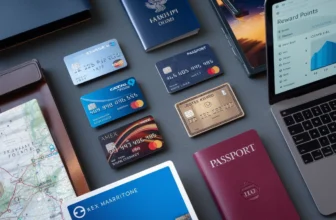
The Only 3 Credit Cards That Actually Matter (And Why Most Advice Is Misleading)
Disclosure: This site may contain some affiliate links, but not every link. If you sign up or make a purchase through these links, I may receive a commission at no additional cost to you. However, all opinions are my own.
If you’ve ever searched “best credit cards” on YouTube or Google, you’ve probably seen the same handful of options pop up time and again—Amex Platinum, Chase Sapphire, maybe a flashy rewards card or two. But here’s a truth most financial influencers won’t tell you: many of them aren’t recommending those cards because they’re the best for you. They’re doing it because they’re getting paid handsomely for it.
After personally spending millions of dollars on credit cards for both personal and business purposes, I’ve learned a thing or two. In this blog post, I’m going to cut through the noise, expose the affiliate marketing traps, and give you a clean, no-fluff breakdown of the only three credit cards actually worth considering.
Part 1: The Truth About the Credit Card Affiliate Industry
Why You Keep Seeing the Same Cards
The credit card affiliate industry is a multi-billion-dollar machine. Major issuers like Chase and American Express offer huge payouts to websites, bloggers, and YouTubers who successfully refer new cardholders.
- Chase can pay up to $500 per person per year for referrals.
- Amex offers as much as $400 per referral—and sometimes more for influencers with large audiences.
That’s why you constantly hear about cards like the Amex Platinum—even though it’s overkill for the average person. This content is not created with your financial interests in mind. It’s optimized for commission.
While there’s nothing inherently wrong with earning affiliate income, the lack of transparency and genuine guidance has created a space flooded with biased recommendations.
💡 Pro Tip: Always check if a recommendation is affiliated. Then ask: “Would this person still recommend the card if they weren’t getting paid?”
Part 2: Busting the 3 Biggest Credit Card Myths
Before we dive into the three cards that actually matter, let’s bust a few common myths that cause more harm than good.
Myth #1: You Need to Maximize Every Perk
It’s tempting to chase every little benefit—rental car upgrades, dining credits, hotel discounts—but how often do these perks translate into real savings?
Consider this:
- That $100 car rental upgrade perk? Useless if you rent a car once a year.
- Lounge access? Great—until you realize most lounges are overcrowded and serve average food.
Time is your most valuable asset. Don’t waste hours combing through benefit catalogs or tracking obscure category bonuses. Choose a card that fits your lifestyle, use it strategically, and move on.
Myth #2: Travel Hacking Is Always Worth It
Travel hacking sounds exciting—redeeming miles, finding loopholes, unlocking luxury perks. But for many, the hours spent gaming the system aren’t justified.
If you’re building VLOOKUP-powered spreadsheets and setting reminders to transfer points at the perfect moment, ask yourself:
“Am I making more money than I’m saving?”
Yes, travel rewards can be valuable. But they shouldn’t dominate your financial strategy—especially if you’re not a frequent flyer.
Also Read: Top Limited-Time Credit Card Offers to Maximize Your Travel and Cashback Rewards
Myth #3: Premium Cards Are Required for Great Travel
Here’s the reality: wealth > perks.
The best travel upgrade isn’t a lounge pass—it’s being able to afford the trip you want. If your income doesn’t justify a premium card’s annual fee, don’t force it.
Many no-fee cashback cards offer solid benefits without the pressure of maximizing every feature.
Part 3: The Only 3 Credit Cards That Are Actually Worth It
Let’s strip away the noise and look at the only three credit cards I consistently recommend. No gimmicks, no affiliate fluff—just practical, real-world use.
1. Fidelity® Rewards Visa Signature® Card
Best For: Everyday, no-hassle cashback
- 2% unlimited cash back on every purchase
- No annual fee
- Rewards deposited directly into a Fidelity account (encouraging long-term investing)
This card is a workhorse. No rotating categories. No quarterly activations. Just a straight 2% return on everything you buy.
For example, if you spend $2,000 a month on your card, that’s $480 per year in cashback with zero effort.
💡 Use case: Pair this with an investment strategy. Set your cashback to flow directly into a brokerage or IRA for automated wealth building.
2. Chase Sapphire Reserve®
Best For: Frequent travelers who value premium redemptions
- 3x points on dining and travel
- Up to 10x points when booking through Chase Ultimate Rewards®
- Points transfer to airline and hotel partners at favorable rates
- $300 annual travel credit
- Global Entry/TSA PreCheck reimbursement
- Lounge access
Yes, the annual fee is steep at $550, but the benefits can easily outweigh the cost if you travel frequently. That $300 travel credit reduces the effective fee to $250, and point transfers can unlock tremendous value—think business-class flights or luxury stays at a fraction of the cost.
✈️ Real-world example: I once used Chase points to book $60,000 worth of business-class flights entirely on points.
If you’re a globetrotter, this is your go-to.
3. American Express® Platinum Card
Best For: High-end hotel perks (but overrated otherwise)
- Access to Amex Fine Hotels & Resorts (FHR) program
- $200 hotel credit, $200 airline fee credit, $240 digital entertainment credit
- Complimentary elite status with Marriott Bonvoy & Hilton Honors
- Centurion Lounge and Priority Pass access
- $695 annual fee (yes, it’s expensive)
Let’s be honest: the Amex Platinum is the most overhyped premium card out there. Lounges are overcrowded, benefits are over-marketed, and many perks are hard to use without a luxury lifestyle.
The only reason I personally keep this card? Amex Fine Hotels & Resorts.
If you book a luxury hotel through this program, you often receive:
- Free daily breakfast (worth $60–$80 per day)
- $100 property credit
- Room upgrade (when available)
- Early check-in and late checkout
🏨 Example: Booking The Langham Chicago through FHR recently saved me ~$300 in perks alone.
If you don’t stay in upscale hotels or use a travel advisor, this card may not be for you.
Final Thoughts: Keep It Simple, Keep It Smart
The credit card world is cluttered with noise—endless recommendations, affiliate traps, and overhyped benefits. But the path to smart credit card usage is actually simple:
- Use a straightforward cashback card (like Fidelity 2%) for everyday purchases.
- Consider a premium travel card (Chase Sapphire Reserve) only if you fly or dine often.
- Reserve the Amex Platinum for luxury hotel stays—otherwise, skip it.
✅ Rule of thumb: If a card doesn’t fit your lifestyle, it’s not a smart financial tool—it’s an unnecessary expense.
Join the Conversation
What’s the most overrated credit card you’ve ever used? Drop your story in the comments—let’s get real about what works and what doesn’t.
And if you’re tired of financial fluff and want grounded, practical advice to help you build real wealth, be sure to subscribe for more content like this.
Disclaimer: This post is not sponsored. All opinions are based on personal experience and research. Always consider your personal financial situation before applying for any credit product.
Also Read: best credit cards 2025






